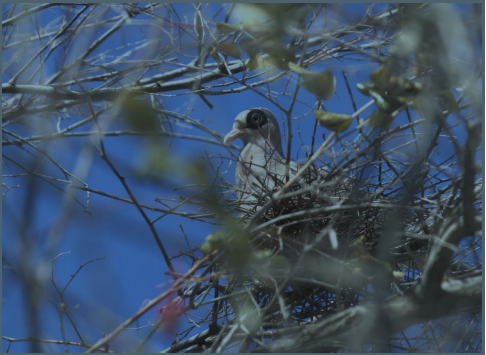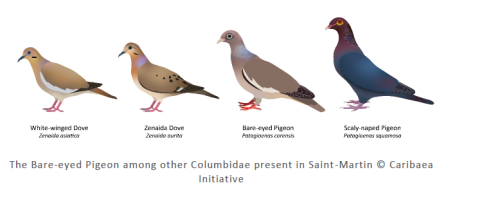 Saint Martin:--- Recently, the island of Saint-Martin has been confronted with a new threat: the invasion of its territory by the Bare-eyed Pigeon (Patagioenas corensis). Although the species, native to South America, was first observed on the island only about ten years ago, a newly published scientific study confirms an alarming scenario: its rapid expansion across the entire island. This invasion, with potentially significant ecological consequences, can only be controlled through strong and immediate measures.
Saint Martin:--- Recently, the island of Saint-Martin has been confronted with a new threat: the invasion of its territory by the Bare-eyed Pigeon (Patagioenas corensis). Although the species, native to South America, was first observed on the island only about ten years ago, a newly published scientific study confirms an alarming scenario: its rapid expansion across the entire island. This invasion, with potentially significant ecological consequences, can only be controlled through strong and immediate measures.
Invasive Exotic Species: A Threat to the Environment
Invasive exotic species pose a considerable threat to biodiversity, particularly in insular environments where ecosystems are more vulnerable. Introduced intentionally or accidentally, these species generally have a negative impact on native species, potentially leading to their extinction in extreme cases. Their economic impact can be equally significant, causing damage to agriculture, fishing,
tourism, and public health through the transport of pathogens. Preventing their introduction or establishment is, therefore, a priority for conservation biologists.
The Bare-eyed Pigeon in Saint-Martin: An Alarming Situation
A scientific study led by Dr. Christopher Cambrone (scientific project coordinator at Caribaea Initiative and specialist in the study of columbids in the Antilles) and two colleagues provides unprecedented evidence of the species' progressive invasion since its introduction to Saint-Martin.
In addition to recent field observations made by the researchers themselves, the study heavily relied on data collected over several years through "citizen science." The use of this kind of data is possible because the Bare-eyed Pigeon is particularly easy to recognize, notably due to the large blue circles around its eyes, which distinctly differentiate it from other columbid species on the island. Therefore, observations of the species made by amateur or experienced naturalists, compiled on dedicated platforms, can be considered reliable and used to trace the species' expansion. The researchers analyzed all available data for the species within the famous eBird database, accessible to everyone.
The first observation of the Bare-eyed Pigeon on the island dates back to January 21, 2013, near "Salines d'Orient" (northeast of the island). Since then, the number of observations has significantly increased, with only about twenty reports between 2013 and 2019 but more than 60 between 2023 and early 2024. A spatial expansion was also highlighted, with sightings initially concentrated in the northern and western regions of the island, before spreading south. This expansion was accompanied by habitat diversification. Initially present in coastal habitats, the species began to increasingly exploit forested and urbanized areas. Finally, the article highlights a significant increase in the Bare-eyed Pigeon population size, with an increasing likelihood of observing multiple individuals at once rather than a single one.
While multiple introductions of the species cannot be ruled out at this time, the population increase and habitat diversification seem more likely to result from the species reproducing on the island from a small number of initially introduced individuals, an hypothesis supported by the observation of an individual nesting in an urban area.
An Ecological Threat Likely to Spread to Other Islands
The proliferation of the Bare-eyed Pigeon poses a threat to native bird species, particularly pigeons and doves, through competition for food resources and nesting sites. The species' adaptability to urban environments further increases its potential for expansion. The problem posed by the introduction of the Bare-eyed Pigeon is not limited to Saint-Martin. The species' flight capabilities, potentially enhanced by favorable winds, could allow it to reach neighboring islands, such as Anguilla and Saint-Barthélemy, in the short or medium term. Furthermore, the Bare-eyed Pigeon is naturally adapted to arid and semi-arid environments, and its regional expansion could be facilitated by climate change, which, according to predictive models, will lead to significant drying of the insular Caribbean during the 21st century.
 Eradicating the Intruder?
Eradicating the Intruder?In cases of exotic species introduction, scientific data shows that there is a very narrow time window, limited to the very first years of establishment, during which it is still possible to act for eradication. After this, species regulation becomes impossible or requires prohibitive human and financial resources. The authors of the study, therefore, make an urgent appeal to local and regional authorities
to take immediate measures to manage this invasion before it is too late. They recommend the rapid eradication of the Bare-eyed Pigeon in Saint-Martin. While trapping could be effective, it is non-selective and requires a significant investment of time. The authors thus suggest quickly placing the Bare-eyed Pigeon on the list of huntable species in Saint-Martin. They also recommend close cooperation between administrative authorities on the French and Dutch parts of the island to coordinate eradication and public awareness campaigns.
The Bare-eyed Pigeon, among other Columbidae present in Saint-Martin © Caribaea Initiative
Reference
Cambrone, C., Levesque, A. & Cézilly, F. 2024. Using citizen science and field surveys to document the introduction, establishment, and rapid spread of the Bare-eyed Pigeon, Patagioenas corensis, on the island of Saint-Martin, West Indies. Biology 13: 585.
Contact: Dr. Christopher Cambrone, This email address is being protected from spambots. You need JavaScript enabled to view it.
This study was conducted as part of the ESPACYPA project, dedicated to the study of several avian species in the Lesser Antilles. The project is led by Caribaea Initiative, a non-profit organization dedicated to the scientific study and conservation of Caribbean biodiversity, with financial support from the Fédération Départementale des Chasseurs de Guadeloupe and the DEAL Guadeloupe (via the Plan France Relance).












